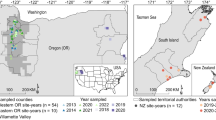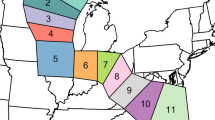Abstract
Following establishment in a new environment, invasive species expand their range through stratified diffusion, the coupling of local growth and spatial spread with long-distance movement of propagules that found new colonies. Consequently, the stages of arrival and establishment serially repeat until the entire habitat susceptible to invasion is occupied. An empirical example of such a phenomenon is the gypsy moth, Lymantria dispar (L.), invasion of northeastern Minnesota. Under a regional management program, a trapping grid is deployed along the L. dispar leading edge to detect male moth presence and inform management decisions. However, the presence of moths does not always indicate reproducing populations, and moths dispersing from populations behind the front can obscure the presence of latent invasions. We analyzed trapping data during the arrival and establishment of L. dispar in this region (2000–2012), supplemented with sentinel trap data to ascertain the timing of male moth flight (2005–2009), and derived yearly phenological predictions for male moth flight. We also used a male wing morphology metric (2007–2009) to further quantify spatial and temporal patterns associated with the L. dispar invasion. We provide evidence of an established L. dispar population when analyses suggest spatial randomness in trap catch data, and how the presence of phenologically distinct, immigrating adult moths from source populations outside of Minnesota recorded from sentinel traps could lead to the overestimation of the abundance of an established population. This work highlights the complexity of the initial invasion process even in a well-studied system for which a sensitive monitoring program exists.





Similar content being viewed by others
References
Aukema JE, McCullough DG, Von Holle B et al (2010) Historical accumulation of nonindigenous forest pests in the continental US. Bioscience 60:886–897
Beirne BP (1975) Biological control attempts by introductions against pest insects in the field in Canada. Can Entomol 107:225–236
Bigsby KM, Tobin PC, Sills EO (2011) Anthropogenic drivers of gypsy moth spread. Biol Invasions 13:2077–2090
Bjørnstad ON (2012) Package ‘ncf.’ spatial nonparametric covariance functions. http://cran.r-project.org/web/packages/ncf/
Bjørnstad O, Falck W (2001) Nonparametric spatial covariance functions: estimating and testing. Environ Ecol Stat 8:53–70
Brockerhoff EG, Bain J, Kimberley M et al (2006) Interception frequency of exotic bark and ambrosia beetles (Coleoptera: Scolytinae) and relationship with establishment in New Zealand and worldwide. Can J For Res 36:289–298
Brockerhoff EG, Kimberley M, Liebhold AM et al (2014) Predicting how altering propagule pressure changes establishment rates of biological invaders across species pools. Ecology 95:594–601
Capinera JL, Barbosa P (1976) Dispersal of first-instar gypsy moth larvae in relation to population quality. Oecologia 26:53–64
Carter MR, Ravlin FW, McManus ML (1991) Changes in gypsy moth (Lepidoptera: Lymantriidae) fecundity and male wing length resulting from defoliation. Environ Entomol 20:1042–1047
Colautti R, Grigorovich I, MacIsaac H (2006) Propagule pressure: a null model for biological invasions. Biol Invasions 8:1023–1037
Doane CC, McManus ML (1981) The gypsy moth: research toward integrated pest management. Technical Bulletin 1584, United States Department of Agriculture, Washington, DC
Dvorak RG, Watson AE, Christensen N et al (2012) The boundary waters canoe area wilderness: examining changes in use, users, and management challenges. United States Department of Agriculture, Rocky Mountain Research Station, Research Paper RMRS-RP-91
Efron B, Tibshirani RJ (1993) An introduction to the bootstrap. Chapman & Hall, London
Elkinton JS, Liebhold AM (1990) Population dynamics of gypsy moth in North America. Annu Rev Entomol 35:571–596
Frank KL, Tobin PC, Thistle HW Jr et al (2013) Interpretation of gypsy moth frontal advance using meteorology in a conditional algorithm. Int J Biometeorol 57:459–473
Gray DR (2004) The gypsy moth life stage model: landscape-wide estimates of gypsy moth establishment using a multi-generational phenology model. Ecol Model 176:155–171
Gray DR (2009) Age-dependent postdiapause development in the gypsy moth (Lepidoptera: Lymantriidae) life stage model. Environ Entomol 38:18–25
Gray DR, Ravlin FW, Braine JA (2001) Diapause in the gypsy moth: a model of inhibition and development. J Insect Physiol 47:173–184
Hajek AE, Tobin PC (2009) North American eradications of Asian and European gypsy moth. In: Hajek AE, Glare TR, O’Callaghan M (eds) Use of microbes for control and eradication of invasive arthropods. Springer, New York, pp 71–89
Hanna M (1982) Gypsy moth (Lepidoptera: Lymantriidae) history of eradication efforts in Michigan, 1954–1981. Great Lakes Entomol 15:191–198
Haukioja E, Ossipov V, Lempa K (2002) Interactive effects of leaf maturation and phenolics on consumption and growth of a geometrid moth. Entomol Exp Appl 104:125–136
Hunter AF (1993) Gypsy moth population sizes and the window of opportunity in the spring. Oikos 68:531–538
Hunter AF, Elkinton JS (1999) Interaction between phenology and density effects on mortality from natural enemies. J Anim Ecol 68:1093–1100
Hunter AF, Elkinton JS (2000) Effects of synchrony with host plant on populations of a spring-feeding Lepidopteran. Ecology 81:1248–1261
Johnson DM, Liebhold AM, Tobin PC et al (2006) Allee effects and pulsed invasion of the gypsy moth. Nature 444:361–363
Krause SC, Walker MA, Klonowski J et al (1994) Gypsy moth in Wisconsin—1994. In: Proceedings of the annual gypsy moth review, Portland, OR, pp 351–356
Lance DR, Elkinton JS, Schwalbe CP (1987) Microhabitat and temperature effects explain accelerated development during outbreaks of the gypsy moth (Lepidoptera: Lymantriidae). Environ Entomol 16:202–205
Lewis MA, Kareiva P (1993) Allee dynamics and the spread of invading organisms. Theor Popul Biol 43:141–158
Liebhold AM, Tobin PC (2006) Growth of newly established alien populations: comparison of North American gypsy moth colonies with invasion theory. Popul Ecol 48:253–262
Liebhold AM, Tobin PC (2008) Population ecology of insect invasions and their management. Annu Rev Entomol 53:387–408
Liebhold A, Mastro V, Schaefer PW (1989) Learning from the legacy of Leopold Trouvelot. Bull Entomol Soc Am 35:20–22
Liebhold AM, Halverson JA, Elmes GA (1992) Gypsy moth invasion in North America: a quantitative analysis. J Biogeogr 19:513–520
Liebhold AM, Gottschalk KW, Muzika RM et al (1995) Suitability of North American tree species to the gypsy moth: a summary of field and laboratory tests. USDA Forest Service General Technical Report NE-211, Radnor, PA
Liebhold AM, Brockerhoff EG, Garrett LJ et al (2012) Live plant imports: the major pathway for forest insect and pathogen invasions of the United States. Front Ecol Environ 10:135–143
Liebhold AM, Berec L, Brockeroff EG et al (2016) Eradication of invading insect populations: from concepts to applications. Annu Rev Entomol 61:335–352
Lockwood JL, Hoopes M, Marchetti M (2007) Invasion ecology. Blackwell, Malden
Lockwood JL, Cassey P, Blackburn TM (2009) The more you introduce the more you get: the role of colonization pressure and propagule pressure in invasion ecology. Divers Distrib 15:904–910
Ludsin SA, Wolfe AD (2001) Biological invasion theory: Darwin’s contributions from the origin of species. Bioscience 51:780–789
Mason CJ, McManus ML (1981) Larval dispersal of the gypsy moth. In: Doane CC, McManus ML (eds) The gypsy moth: research toward integrated pest management. USDA Forest Service, Technical Bulletin 1584, Washington, DC, pp 161–202
McCullough DG, Work TT, Cavey JF et al (2006) Interceptions of nonindigenous plant pests at US ports of entry and border crossings over a 17-year period. Biol Invasions 8:611–630
Minnesota Department of Natural Resources (2015) Laurentian mixed forest province. http://dnr.state.mn.us/ecs/212/index.html
National Climatic Data Center (2015) http://www.ncdc.noaa.gov
National Oceanic and Atmospheric Administration (2015) National weather service. http://www.weather.gov/
Odell TM, Mastro VC (1980) Crepuscular activity of gypsy moth adults (Lymantria dispar). Environ Entomol 9:613–617
Parry D, Spence JR, Volney WJA (1998) Bud break phenology and natural enemies mediate survival of early instar forest tent caterpillar (Lepidoptera: Lasiocampidae). Environ Entomol 27:1368–1374
R Development Core Team (2015) The R project for statistical computing, Vienna, Austria. http://www.R-project.org/
Raupp MJ, Werren JH, Sadof CS (1988) Effects of short-term phenological changes in leaf suitability on the survivorship, growth, and development of gypsy moth (Lepidoptera: Lymantriidae) larvae. Environ Entomol 17:316–319
Régnière J, Sharov AA (1998) Phenology of Lymantria dispar (Lepidoptera: Lymantriidae), male flight and the effect of moth dispersal in heterogeneous landscapes. Int J Biometeorol 41:161–168
Régnière J, Sharov AA (1999) Simulating temperature-dependent ecological processes at the sub-continental scale: male gypsy moth flight phenology as an example. J Biometeorol 42:146–152
Riley CV, Vasey G (1870) Importd insects and native American insects. Am Entomol 2:110–112
Robinet C, Lance DR, Thorpe KW et al (2008) Dispersion in time and space affect mating success and Allee effects in invading gypsy moth populations. J Anim Ecol 77:966–973
Sharov AA, Liebhold AM (1998) Model of slowing the spread of gypsy moth (Lepidoptera: Lymantriidae) with a barrier zone. Ecol Appl 8:1170–1179
Sharov AA, Roberts EA, Liebhold AM et al (1995) Gypsy moth (Lepidoptera: Lymantriidae) spread in the central Appalachians: three methods for species boundary estimation. Environ Entomol 24:1529–1538
Shigesada N, Kawasaki K, Takeda Y (1995) Modeling stratified diffusion in biological invasions. Am Nat 146:229–251
Simberloff D (2009) The role of propagule pressure in biological invasions. Annu Rev Ecol Evol Syst 40:81–102
Slow-the-Spread Foundation, Inc (2013) http://www.gmsts.org/
Stockhoff BA (1991) Starvation resistance of gypsy moth, Lymantria dispar (L.) (Lepidoptera: Lymantriidae): tradeoffs among growth, body size, and survival. Oecologia 88:422–429
Tobin PC (2007) Space-time patterns during the establishment of a nonindigenous species. Popul Ecol 49:257–263
Tobin PC, Blackburn LM (2007) Slow the spread: a national program to manage the gypsy moth. USDA Forest Service General Technical Report NRS-6, Newtown Square, PA
Tobin PC, Blackburn LM (2008) Long-distance dispersal of the gypsy moth (Lepidoptera: Lymantriidae) facilitated its initial invasion of Wisconsin. Environ Entomol 37:87–93
Tobin PC, Liebhold AM, Roberts EA (2007) Comparison of methods for estimating the spread of a non-indigenous species. J Biogeogr 34:305–312
Tobin PC, Klein KT, Leonard DS (2009) Gypsy moth (Lepidoptera: Lymantriidae) flight behavior and phenology based upon field-deployed automated pheromone-baited traps. Environ Entomol 38:1555–1562
Tobin PC, Bai BB, Eggen DA et al (2012) The ecology, geopolitics, and economics of managing Lymantria dispar in the United States. Int J Pest Manag 53:195–210
Tobin PC, Liebhold AM, Roberts EA et al (2015) Estimating spread rates of non-native species: the gypsy moth as a case study. In: Venette RC (ed) Pest risk modelling and mapping for invasive alien species. CABI, Boston, pp 131–144
Uelmen JA, Lindroth RL, Tobin PC et al (2016) Effects of winter temperatures, spring degree-day accumulation, and insect population source on phenological synchrony between forest tent caterpillar and host trees. For Ecol Manag 362:241–250
U.S. Forest Service (2016) Forest inventory and analysis national program. http://www.fia.fs.fed.us/
van Asch M, Visser ME (2007) Phenology of forest caterpillars and their host trees: the importance of synchrony. Annu Rev Entomol 52:37–55
Weseloh RM (1985) Dispersal, survival, and population abundance of gypsy moth, Lymantria dispar (Lepidoptera: Lymantriidae), larvae determined by releases and mark-recapture studies. Ann Entomol Soc Am 78:728–735
Williamson M, Fitter A (1996) The varying success of invaders. Ecology 77:1661–1666
Work TT, McCullough DG, Cavey JF et al (2005) Arrival rate of nonindigenous insect species into the United States through foreign trade. Biol Invasions 7:323–332
Acknowledgments
We thank Donna Leonard, John Kyhl, Ken Klein, Laura Blackburn, and Regis Young (USDA Forest Service); Natasha Northrop, Alison Rossow, Erich Borchardt, Cree Bradley, and Bob Kangas (Minnesota Department of Agriculture); and David Nesbitt (College of Environmental Science and Forestry, State University of New York) for valuable laboratory and field support. We are very grateful to Rémi St-Amant (Canadian Forest Service) for providing phenological predictions of L. dispar. We thank Joe Elkington (University of Massachusetts) for helpful comments and suggestions. We acknowledge funds from the Gypsy Moth Slow-the-Spread Foundation, Inc. (Grant Number A106307 to PCT) and the USDA Forest Service, Northern Research Station (Grant Number 11-JV-11242303-053 to DP) in support of this study.
Author information
Authors and Affiliations
Corresponding author
Rights and permissions
About this article
Cite this article
Tobin, P.C., Cremers, K.T., Hunt, L. et al. All quiet on the western front? Using phenological inference to detect the presence of a latent gypsy moth invasion in Northern Minnesota. Biol Invasions 18, 3561–3573 (2016). https://doi.org/10.1007/s10530-016-1248-5
Received:
Accepted:
Published:
Issue Date:
DOI: https://doi.org/10.1007/s10530-016-1248-5




